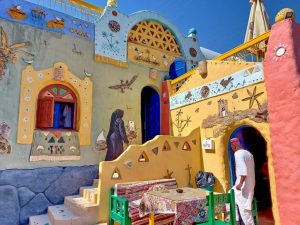History of Luxor Temple
Luxor temple is one of the most beautiful temples in ancient Egypt. The temple was started by King Amenhotep III from Dynasty 18. However, it is believed by some archeologists that the oldest part of the temple dates back to the time of King Mentohotep the founder of the Middle Kingdom. It seems that the ancient kings followed a long-term construction plan to finish the temple in centuries, not decades. The sanctuary, the hypostyle hall, and a colonnade were built by King Amenhotep III.
The smart plan gave out two options, one is to leave the temple as it is by Amenhotep III, and it looked finished even with an entrance that led directly to the colonnade, and the second option was to extend and enlarge the temple starting from that entrance!!
The visitor can easily see the difference in style between the parts of the temple as the columns built by Amenhotep III are all one design which is a cluster of plans representing harvest.
King Tutankhamun -from the dynasty 18- added another colonnade with the style of the open flower capitals to represent irrigation season. He also added some unique statues of him represented in the form of Amen Ra with his wife, all out of white alabaster stone, and the visitor still can see them located at the beginning of Tut’s colonnade.
Then the largest part of the temple built by one king –guess who- was the part of King Ramses II as he added another huge colonnade, statues, and pylons. The columns built by Ramses are all in one design with a bud capital to represent the Nile’s flood season.
King Ramses completed the proposed plan of the temple by building the bud-capital columns, the nowadays outside pylon, and the huge statues of him standing, walking, and sitting on the throne.
The columns of the temple now represent the three seasons of the year in ancient Egypt; Flood, Irrigation, and Harvest seasons.
Components and Description
The temple was attached to Karnak temples. The famous Sphinxes Avenue with the body of the lion and the head of the king were the link between the two complexes.
The Pylons:
On the face of the great pylon are carved episodes from the Battle of Kadesh, when Ramesses and his army defeated the forces of the Hittites and their allies. The obelisk is one of a red granite pair that Ramesses erected in front of the pylon; its twin is now in the Place de la Concorde, in Paris. On the pedestal are carved the four sacred baboons who were the first to greet the morning sun. Three lines of vertical inscription on every face of the obelisk repeat the names and titles of Ramesses the Great: The Horus, Mighty Bull, Exalter of Thebes, Favorite of the Two Goddesses, establishing monuments in Luxor for his father Amen, who placed him upon the throne; Golden Horus, seeking excellent things for him who fashioned him; King of Upper and Lower Egypt, Usermare, Chosen of Re.” It is of interest to note that when the one obelisk was lowered, in order to be transported to France, Ramesses name was also found inscribed on the bottom. Pharaohs were notorious for usurping other pharaohs’ monuments, and Ramesses determined that this was to remain his own. The pyramidal tip of the tall shaft was covered in sheet gold which flashed in the sunlight, symbolizing the sun god Re in his brilliance. Colossal seated statues of Ramesses flank the gateway.
The Mosque of Abu’l Haggag:
Located in the northeast corner of the Court of Ramesses in the Temple of Luxor is the Mosque of Abu’l Haggag. The Sufi sheik spent the last fifty of his ninety years in Luxor. Though Abu’l Haggag died in 1243, the mosque is only 19th century.
The Court of Ramses II:
The south end of the Temple of Luxor was an addition constructed by Ramesses II during the XIX dynasty. The great court is surrounded by well-proportioned papyrus bud capital columns. Reliefs cover the interior walls. Within the court can be seen the tip of the minaret of the mosque of Abu’l Haggag.
The court of Amenhotep III:
Originally built by Amenhotep III, the court was later decorated by Tutankhamun and Horemheb. The Colonnade consists of 14 columns with papyrus capitals. In the entrance to the Colonnade are two statues bearing the name of Ramesses II but the feathers of Tutankhamun. What is left of the walls bear wonderful reliefs of Tutankhamun’s reign and a celebration of the re-establishment of the Amun orthodoxy.
The east and west side of the court has well preserved double rows of papyrus columns with bud capitals, though originally the columns were on the north side as well. The Hypostyle Hall, on the south side, had four rows of eight columns. Reliefs are on both sides of the south wall depicting the coronation of Amenhotep II by the gods. A Roman altar, dedicated to Constantine, is located to the left of the central aisle.
The reliefs of Amenhotep III were whitewashed and painted over in the 3rd or 4th century. The stucco is crumbling, and just recently, beginning to show the reliefs underneath. The second antechamber has four columns (versus eight in the first antechamber) and reliefs of Amenhotep II offering incense to Amun.
The chapel inside the chamber was rebuilt by Alexander the Great and bears his reliefs, while the chamber walls bear the reliefs of Amenhotep II. A small hall is to the east which opens onto the Birth Room, which was built because of Amenhotep II’s claim that he was the son of Amun. Amenhotep II claimed that Amun disguised himself as Tuthmosis IV, entered the queen’s chambers, and breathed the child into her nostrils.










